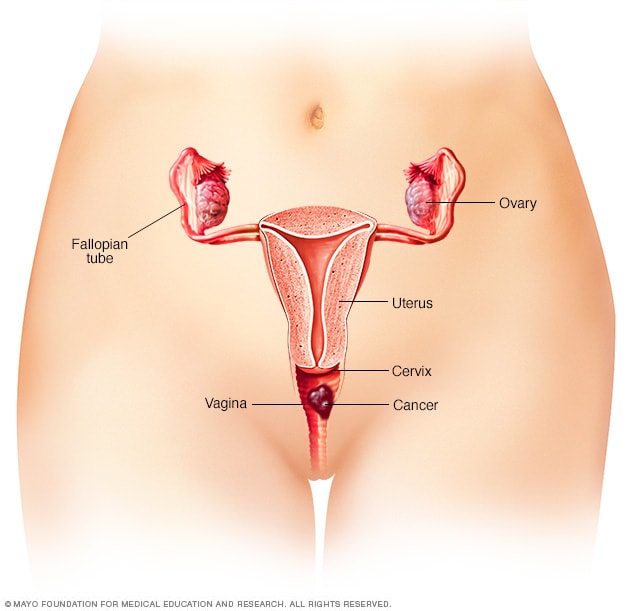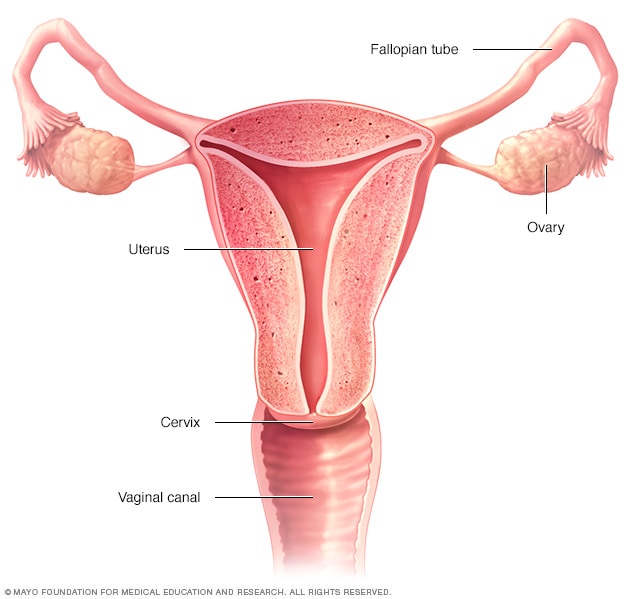Vaginal cancer
Vaginal cancer
overview
Vaginal cancer

Vaginal cancer
Vaginal cancer is cancer that occurs in the vagina - the muscular tube that connects the uterus to the external genitals.
Vaginal cancer is a rare cancer that occurs in your vagina - the muscular tube that connects your uterus to your external genitals. Vaginal cancer most often occurs in the cells that line the surface of your vagina, sometimes called the birth canal.
While several types of cancer can spread to your vagina from other places in your body, cancer that starts in your vagina (primary vaginal cancer) is rare.
A diagnosis of early-stage vaginal cancer has the best chance of recovery. Vaginal cancer that spreads beyond the vagina is much more difficult to treat.
Symptoms
Female reproductive system

Female reproductive system
The ovaries, fallopian tubes, uterus, cervix and vagina (vaginal canal) make up the female reproductive system.
Early-stage vaginal cancer may not cause signs and symptoms. As it progresses, vaginal cancer can cause signs and symptoms such as:
- Ungewöhnliche vaginale Blutungen, zum Beispiel nach dem Geschlechtsverkehr oder nach den Wechseljahren
- Wässriger vaginaler Ausfluss
- Ein Klumpen oder eine Masse in Ihrer Vagina
- Schmerzhaftes Urinieren
- Häufiges Wasserlassen
- Verstopfung
- Schmerzen im Beckenbereich
When to go to the doctor?
See your doctor if you have any signs and symptoms related to vaginal cancer, such as: B. abnormal vaginal bleeding. Because vaginal cancer does not always cause signs and symptoms, follow your doctor's recommendations about when to have routine gynecological exams.
Causes
Layers of vaginal tissue

Layers of vaginal tissue
Vaginal cancer most often begins in the thin, flat squamous cells that line the surface of the vagina. Other types of vaginal cancer may occur in other cells on the surface of the vagina or in the deeper layers of tissue.
It's not clear what causes vaginal cancer. Generally, cancer begins when healthy cells acquire a genetic mutation that turns normal cells into abnormal cells.
Healthy cells grow and multiply at a set rate and eventually die at a set time. Cancer cells grow and multiply out of control, and they don't die. The abnormal cells that accumulate form a mass (tumor).
Cancer cells invade nearby tissue and can break away from an initial tumor to spread (metastasize) elsewhere in the body.
Types of vaginal cancer
Vaginal cancer is divided into different types depending on the type of cell in which the cancer originated. Vaginal cancers include:
- Vaginales Plattenepithelkarzinom, die in den dünnen, flachen Zellen (Plattenepithelzellen) beginnt, die die Oberfläche der Vagina auskleiden, und die häufigste Art ist
- Vaginales Adenokarzinom, die in den Drüsenzellen auf der Oberfläche Ihrer Vagina beginnt
- Vaginales Melanom, das sich in den pigmentproduzierenden Zellen (Melanozyten) Ihrer Vagina entwickelt
- Vaginales Sarkom, die sich in den Bindegewebszellen oder Muskelzellen in den Wänden Ihrer Vagina entwickelt
Risk factors
Factors that may increase your risk of vaginal cancer include:
- Zunehmendes Alter. Ihr Risiko für Vaginalkrebs steigt mit zunehmendem Alter. Die meisten Menschen, bei denen Vaginalkrebs diagnostiziert wird, sind älter als 60 Jahre.
-
Atypical cells in the vagina called vaginal intraepithelial neoplasia.A diagnosis of vaginal intraepithelial neoplasia (VAIN) increases your risk of vaginal cancer.
With VAIN, cells in the vagina appear different than normal cells, but not different enough to be considered cancer. A small number of patients with VAIN will eventually develop vaginal cancer, although doctors are not sure what causes some cases to develop into cancer and others to remain benign.
VAIN is often caused by the sexually transmitted human papillomavirus (HPV), which can cause cervical, vaginal, and vulvar cancers, among other diseases. Vaccines are available that prevent some types of HPV infections.
- Kontakt mit einem Medikament zur Vorbeugung von Fehlgeburten. Wenn Ihre Mutter in den 1950er Jahren während der Schwangerschaft ein Medikament namens Diethylstilbestrol (DES) eingenommen hat, besteht möglicherweise ein erhöhtes Risiko für eine bestimmte Art von Vaginalkrebs, das als klarzelliges Adenokarzinom bezeichnet wird.
Other risk factors that have been linked to an increased risk of vaginal cancer include:
- Mehrere Sexualpartner
- Frühes Alter beim ersten Geschlechtsverkehr
- Rauchen
- HIV infektion
Complications
Vaginal cancer can spread (metastasize) to distant areas of your body, such as: E.g. lungs, liver and bones.
prevention
There is no sure way to prevent vaginal cancer. However, you can reduce your risk if you:
- Unterziehen Sie sich regelmäßigen gynäkologischen Untersuchungen und Pap-Tests. Sie können die Wahrscheinlichkeit erhöhen, dass Vaginalkrebs früh entdeckt wird, indem Sie routinemäßige Beckenuntersuchungen und Pap-Tests durchführen lassen. Wenn Vaginalkrebs in seinen frühesten Stadien entdeckt wird, ist es wahrscheinlicher, dass er geheilt wird. Besprechen Sie mit Ihrem Arzt, wann Sie mit diesen Tests beginnen und wie oft Sie sie wiederholen sollen.
- Fragen Sie Ihren Arzt nach der HPV-Impfung. Eine Impfung zur Vorbeugung einer HPV-Infektion kann Ihr Risiko für Vaginalkrebs und andere HPV-bedingte Krebsarten verringern. Fragen Sie Ihren Arzt, ob eine HPV-Impfung für Sie geeignet ist.
- Nicht rauchen. Wenn Sie rauchen, hören Sie auf. Wenn Sie nicht rauchen, fangen Sie nicht an. Rauchen erhöht das Risiko für Vaginalkrebs.
Vaginal cancer treatment
Sources:
- Niederhuber JE, et al. Krebserkrankungen des Gebärmutterhalses, der Vulva und der Vagina. In: Abeloffs Klinische Onkologie. 5. Aufl. Philadelphia, Pennsylvania: Churchill Livingstone Elsevier; 2014. http://www.clinicalkey.com. Abgerufen am 22. Dezember 2015.
- Vaginalkrebsbehandlung (PDQ). Nationales Krebs Institut. http://www.cancer.gov/types/vaginal/patient/vaginal-treatment-pdq. Abgerufen am 21. Februar 2016.
- Lentz GM, et al. Bösartige Erkrankungen der Vagina. In: Umfassende Gynäkologie. 6. Aufl. Philadelphia, Pennsylvania: Mosby Elsevier; 2012. http://www.clinicalkey.com. Abgerufen am 22. Dezember 2015.
- Hoffman BL, et al. Vaginaler Krebs. In: Williams Gynäkologie. 2. Aufl. New York, NY: Die McGraw-Hill-Unternehmen; 2012. http://accessmedicine.com/. Abgerufen am 21. Februar 2016.
- Becken-Exenteration. Amerikanische Krebs Gesellschaft. http://www.cancer.org/treatment/treatmentsandsideeffects/physicalsideeffects/sexualsideeffectsinwomen/sexualityforthewoman/sexuality-for-women-with-cancer-tot-pelvic-exenterat. Abgerufen am 21. Februar 2016.
- Sich Zeit nehmen: Unterstützung für Menschen mit Krebs. Nationales Krebs Institut. http://www.cancer.gov/publications/patient-education/taking-time. Abgerufen am 21. Februar 2016.
- Karam A. et al. Vaginaler Krebs. http://www.uptodate.com/home. Abgerufen am 21. Februar 2016.

 Suche
Suche
 Mein Konto
Mein Konto